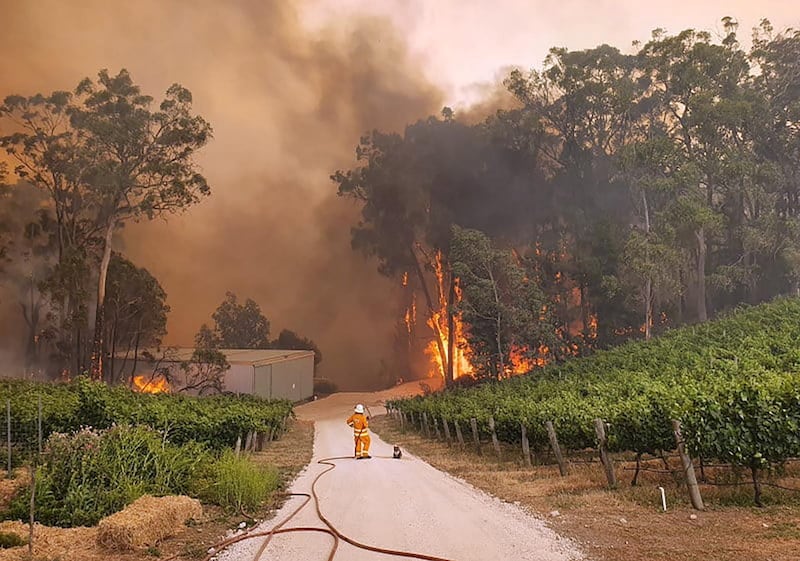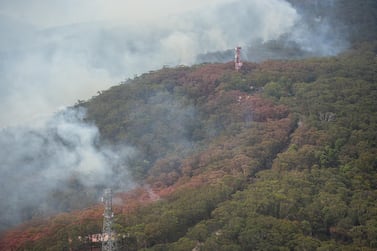After weeks of watching my homeland burn, it was a picture from Cudlee Creek, a small town in South Australia, which finally undid me.
A firefighter stands, weight resting on one leg, heavy red hose tucked under the opposite arm, surveying the burning gumtrees ahead. At his feet sits a koala, apparently seeking protection.
But I didn’t see the marsupial at first. With its vineyards and tall eucalyptus trees, the farmland in the picture was so familiar; I thought for a nano-second that it was my own hometown in Western Australia that was alight.
It easily could have been. The surrounding areas have been under threat plenty of times before and I remember the sight of smouldering trees – and the smell of wildfire smoke – well.
Living on a bush-covered rural property that had only one escape route via a driveway through cathedral-like arches of dry tree branches, we always knew that if a fire came close our family would bundle into the car leave quickly for the safety of town. We also knew what to grab and take with us: the dog and a big box of family photographs.
If we somehow got stuck, there was a pond to jump into – never get in the rainwater tank, my parents warned, the water could boil or you could suffocate in the tiny space. We could cover our heads with wet towels to protect our lungs from hot smoke.
One time a fire was raging just a few kilometres away from our house. After hearing that it had jumped containment lines from a local shopkeeper on the way home from school, we rushed back to clean leaves from the gutters and await updates. Fortunately, it did not jump the river that stood between the fire front and our home.
Later as a journalist and editor, I would help coordinate news coverage for huge fires that consumed dozens of homes in Perth and the famous surfing town of Margaret River. People would call in from where they had stopped at emergency roadblocks, desperate to know if we had any information or pictures that could tell them if their houses and animals had survived.
The Australia I know is a land of extremes – seemingly always in a state of feast or famine, fire or flood. But the scale of the current crisis has now gone beyond anyone’s wildest nightmare. Bushfires have destroyed at least four million hectares (9.9 million acres) across the country. To put that in perspective, it is an area about half the size of the UAE.
So far, 10 people have died, including a firefighter who tragically lost his life while battling a blaze in New South Wales on Monday. The toll on Australia’s wildlife will be immeasurable. Millions of animals have been killed, including huge numbers of koalas, which have drawn the world’s attention to the disaster as the usually shy creatures seek out humans for protection and water.
My home state of Western Australia has so far been spared the extreme devastation wreaked upon the east of the country, but after unusually hot and dry conditions leading into the Summer and with the “fire season” coming into full swing, the threat is still looming. A wildfire has been burning since Boxing Day in the Stirling Ranges – about 70km from my family’s home.
As a wildlife lover, my Twitter feed is usually full of fellow nature enthusiasts recording their happy observations of the local flora and fauna around Australia. Now their photos are set against the backdrop of red skies and charred landscapes. They are putting out water and food for desperate creatures, often seen gasping for air.
The Great Southern, where I am from, is an area rich in biodiversity, with some plants and animals occurring nowhere else in the world, from rare orchids to tiny marsupials. One species, the Gilbert’s Potoroo, has only 30-40 animals left and could be wiped out by a single blaze.
Every year the “fire season” gets worse in Australia, fuelled by increasingly extreme temperatures and droughts that turn the bush into a brittle tinderbox. Meanwhile firefighters, who have watched as conditions have turned apocalyptic over the past 20 years, are forced to plead with the federal Government for more support and action on climate change.
In response Australian Prime Minister Scott Morrison, who as Treasurer once brandished a lump of coal in parliament, has said it would be “reckless” and “job-destroying” to scale down the country’s coal industry.
Mr Morrison's decision to go on holiday to Hawaii while the country faces this monumental crisis has further raised questions among Australians, who are now being forced to come to terms with their new existence on the frontline of the global climate emergency.
The question now is how long can we stand to watch Australia burn?
Louise Burke is the Homepage Editor at The National






